Marketing Case Study: Gillette's Reverse Innovation
VerifiedAdded on 2019/09/19
|6
|1283
|2241
Case Study
AI Summary
This case study analyzes Gillette's reverse innovation strategy in India, focusing on the drivers behind its approach, particularly the introduction of the Gillette Guard razor. It examines whether Gillette compromised standardization for localization, concluding that it was a long-term success. The study also provides an example of another company, Nestle, and its product innovation with NESCAFÉ SUNRISE INSTA-FILTER to meet the needs of low-income consumers in India. The study covers market and operational strategies. The analysis highlights the importance of understanding local market needs and adapting strategies accordingly for successful international marketing. References from various sources support the analysis.
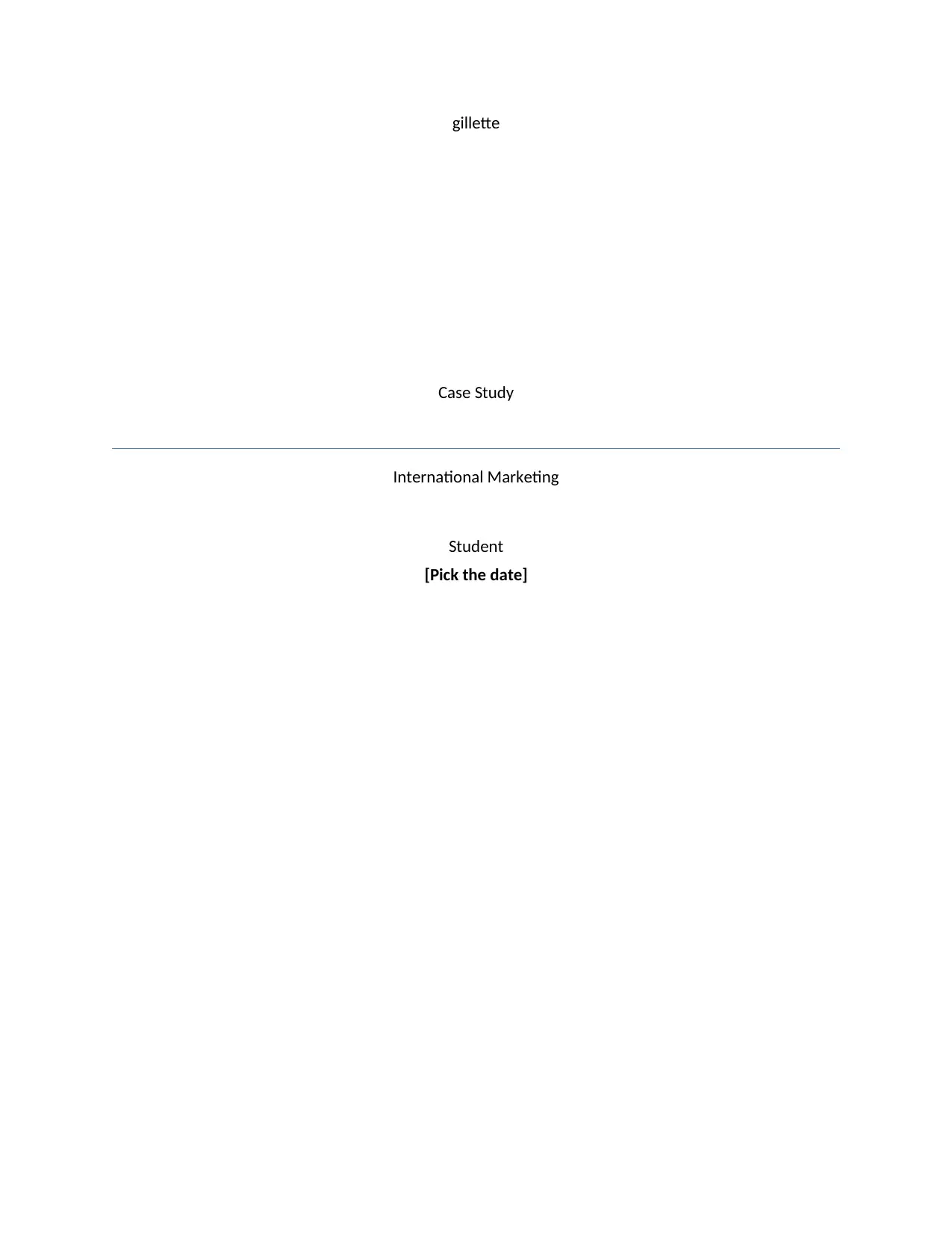
gillette
Case Study
International Marketing
Student
[Pick the date]
Case Study
International Marketing
Student
[Pick the date]
Paraphrase This Document
Need a fresh take? Get an instant paraphrase of this document with our AI Paraphraser
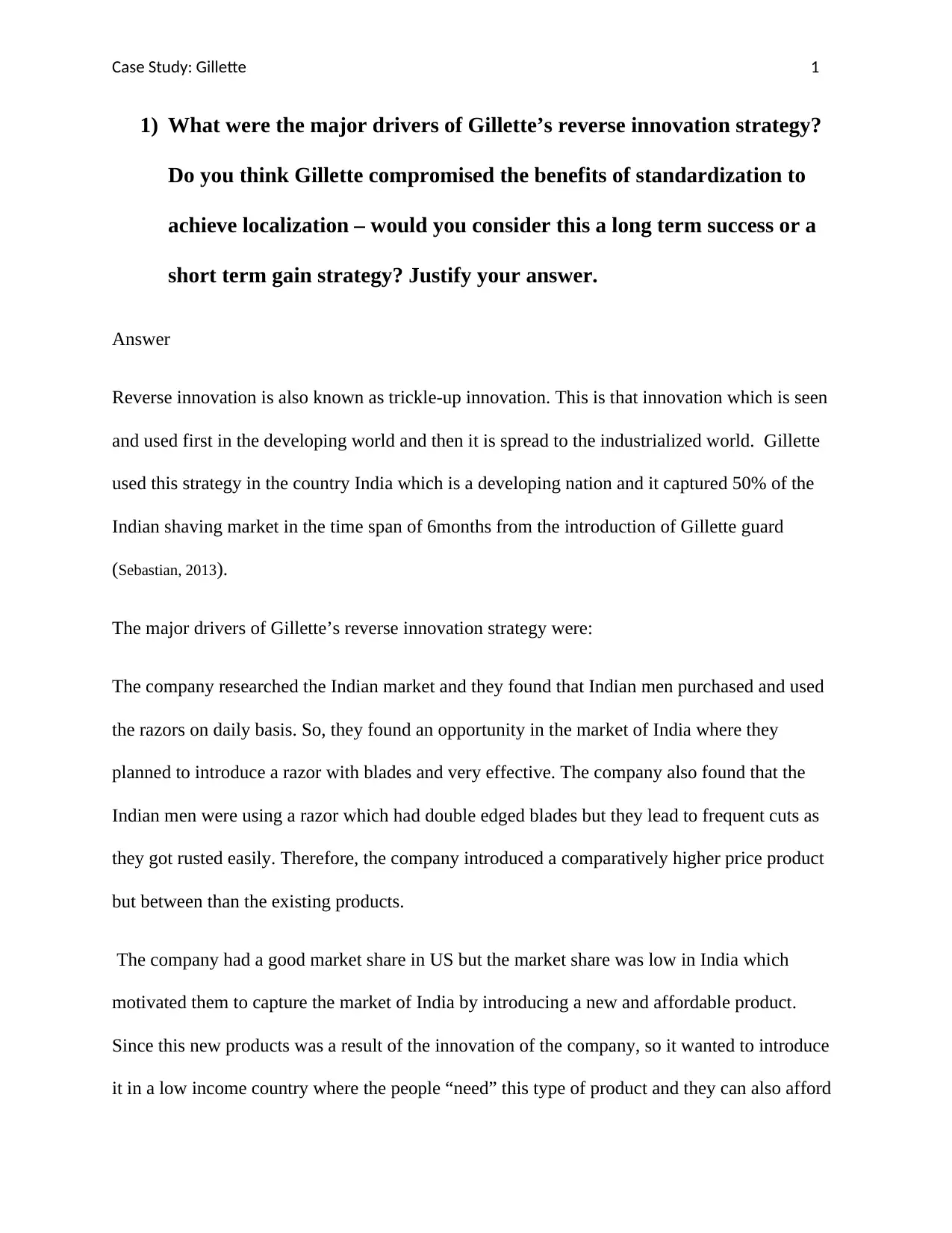
Case Study: Gillette 1
1) What were the major drivers of Gillette’s reverse innovation strategy?
Do you think Gillette compromised the benefits of standardization to
achieve localization – would you consider this a long term success or a
short term gain strategy? Justify your answer.
Answer
Reverse innovation is also known as trickle-up innovation. This is that innovation which is seen
and used first in the developing world and then it is spread to the industrialized world. Gillette
used this strategy in the country India which is a developing nation and it captured 50% of the
Indian shaving market in the time span of 6months from the introduction of Gillette guard
(Sebastian, 2013).
The major drivers of Gillette’s reverse innovation strategy were:
The company researched the Indian market and they found that Indian men purchased and used
the razors on daily basis. So, they found an opportunity in the market of India where they
planned to introduce a razor with blades and very effective. The company also found that the
Indian men were using a razor which had double edged blades but they lead to frequent cuts as
they got rusted easily. Therefore, the company introduced a comparatively higher price product
but between than the existing products.
The company had a good market share in US but the market share was low in India which
motivated them to capture the market of India by introducing a new and affordable product.
Since this new products was a result of the innovation of the company, so it wanted to introduce
it in a low income country where the people “need” this type of product and they can also afford
1) What were the major drivers of Gillette’s reverse innovation strategy?
Do you think Gillette compromised the benefits of standardization to
achieve localization – would you consider this a long term success or a
short term gain strategy? Justify your answer.
Answer
Reverse innovation is also known as trickle-up innovation. This is that innovation which is seen
and used first in the developing world and then it is spread to the industrialized world. Gillette
used this strategy in the country India which is a developing nation and it captured 50% of the
Indian shaving market in the time span of 6months from the introduction of Gillette guard
(Sebastian, 2013).
The major drivers of Gillette’s reverse innovation strategy were:
The company researched the Indian market and they found that Indian men purchased and used
the razors on daily basis. So, they found an opportunity in the market of India where they
planned to introduce a razor with blades and very effective. The company also found that the
Indian men were using a razor which had double edged blades but they lead to frequent cuts as
they got rusted easily. Therefore, the company introduced a comparatively higher price product
but between than the existing products.
The company had a good market share in US but the market share was low in India which
motivated them to capture the market of India by introducing a new and affordable product.
Since this new products was a result of the innovation of the company, so it wanted to introduce
it in a low income country where the people “need” this type of product and they can also afford
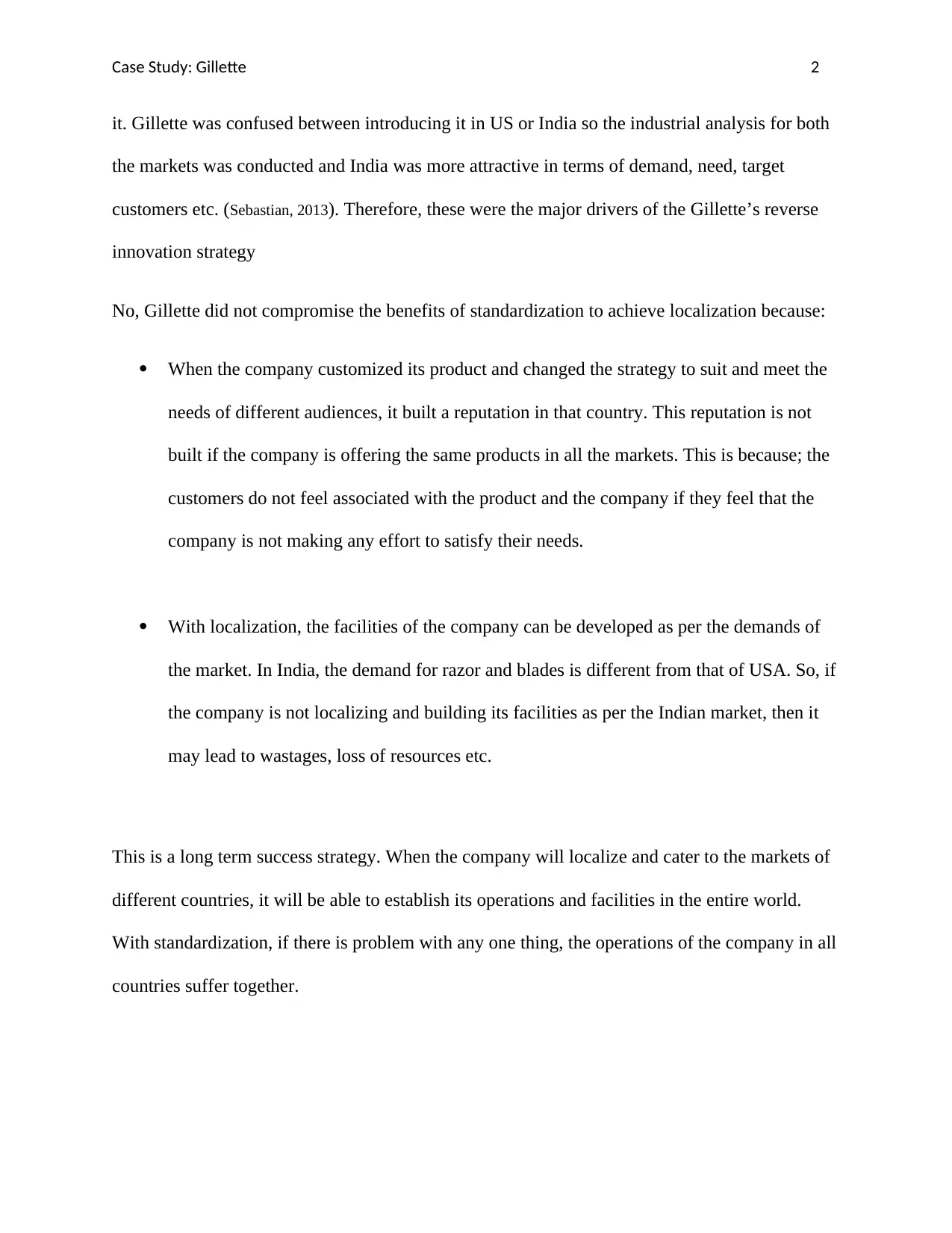
Case Study: Gillette 2
it. Gillette was confused between introducing it in US or India so the industrial analysis for both
the markets was conducted and India was more attractive in terms of demand, need, target
customers etc. (Sebastian, 2013). Therefore, these were the major drivers of the Gillette’s reverse
innovation strategy
No, Gillette did not compromise the benefits of standardization to achieve localization because:
When the company customized its product and changed the strategy to suit and meet the
needs of different audiences, it built a reputation in that country. This reputation is not
built if the company is offering the same products in all the markets. This is because; the
customers do not feel associated with the product and the company if they feel that the
company is not making any effort to satisfy their needs.
With localization, the facilities of the company can be developed as per the demands of
the market. In India, the demand for razor and blades is different from that of USA. So, if
the company is not localizing and building its facilities as per the Indian market, then it
may lead to wastages, loss of resources etc.
This is a long term success strategy. When the company will localize and cater to the markets of
different countries, it will be able to establish its operations and facilities in the entire world.
With standardization, if there is problem with any one thing, the operations of the company in all
countries suffer together.
it. Gillette was confused between introducing it in US or India so the industrial analysis for both
the markets was conducted and India was more attractive in terms of demand, need, target
customers etc. (Sebastian, 2013). Therefore, these were the major drivers of the Gillette’s reverse
innovation strategy
No, Gillette did not compromise the benefits of standardization to achieve localization because:
When the company customized its product and changed the strategy to suit and meet the
needs of different audiences, it built a reputation in that country. This reputation is not
built if the company is offering the same products in all the markets. This is because; the
customers do not feel associated with the product and the company if they feel that the
company is not making any effort to satisfy their needs.
With localization, the facilities of the company can be developed as per the demands of
the market. In India, the demand for razor and blades is different from that of USA. So, if
the company is not localizing and building its facilities as per the Indian market, then it
may lead to wastages, loss of resources etc.
This is a long term success strategy. When the company will localize and cater to the markets of
different countries, it will be able to establish its operations and facilities in the entire world.
With standardization, if there is problem with any one thing, the operations of the company in all
countries suffer together.
⊘ This is a preview!⊘
Do you want full access?
Subscribe today to unlock all pages.

Trusted by 1+ million students worldwide

Case Study: Gillette 3
2) Provide an example of another major company that adapted an existing
product or invested in product innovation to meet the needs of low
income consumers in a country. Describe the product, market and
operations strategies used? Was it successful?
Answer
Nestle is another company which invested in product innovation to cater the needs of the low
income consumers in the country.
Nestle researched various markets where they were looking for an opportunity to innovate the
product and introduce it and they were also looking for the options where the customer easily
adapt to the new product innovation. So, the company found that Indians liked the taste of filter
coffee but they could not always buy a machine to have a cup of coffee because most of the
people in India prefer tea over coffee. But the coffee lovers wanted to taste the filter coffee
whenever they went to drink one.
So, nestle introduced NESCAFÉ SUNRISE INSTA-FILTER which was an innovation in its
coffee and provided the taste of filter coffee without any need for a filter. It was made from
100% coffee beans and the taste and aroma of the coffee was just great (Malhotra, 2015).
Since the product was innovative, so the costs of the product were higher than the normal coffee
packet. Therefore, the company partnered with Snapdeal and started selling the product in bulk
so that it is able to cover the cost and the low income consumers could also buy it easily. At
Snapdeal, the product was sold at INR 60 for 24kg pack of coffee which has 15 sachets of coffee
(Sen, 2016).
2) Provide an example of another major company that adapted an existing
product or invested in product innovation to meet the needs of low
income consumers in a country. Describe the product, market and
operations strategies used? Was it successful?
Answer
Nestle is another company which invested in product innovation to cater the needs of the low
income consumers in the country.
Nestle researched various markets where they were looking for an opportunity to innovate the
product and introduce it and they were also looking for the options where the customer easily
adapt to the new product innovation. So, the company found that Indians liked the taste of filter
coffee but they could not always buy a machine to have a cup of coffee because most of the
people in India prefer tea over coffee. But the coffee lovers wanted to taste the filter coffee
whenever they went to drink one.
So, nestle introduced NESCAFÉ SUNRISE INSTA-FILTER which was an innovation in its
coffee and provided the taste of filter coffee without any need for a filter. It was made from
100% coffee beans and the taste and aroma of the coffee was just great (Malhotra, 2015).
Since the product was innovative, so the costs of the product were higher than the normal coffee
packet. Therefore, the company partnered with Snapdeal and started selling the product in bulk
so that it is able to cover the cost and the low income consumers could also buy it easily. At
Snapdeal, the product was sold at INR 60 for 24kg pack of coffee which has 15 sachets of coffee
(Sen, 2016).
Paraphrase This Document
Need a fresh take? Get an instant paraphrase of this document with our AI Paraphraser
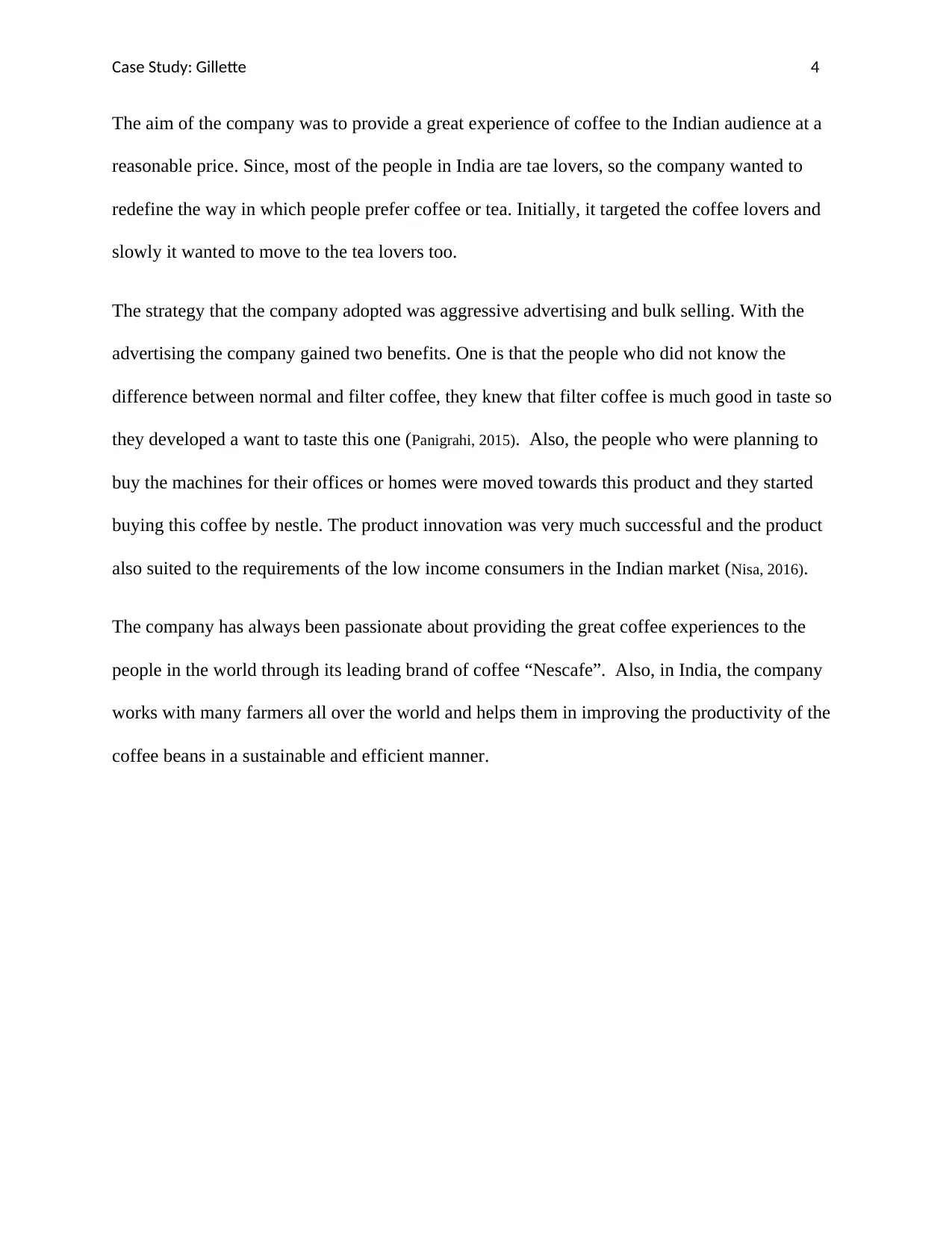
Case Study: Gillette 4
The aim of the company was to provide a great experience of coffee to the Indian audience at a
reasonable price. Since, most of the people in India are tae lovers, so the company wanted to
redefine the way in which people prefer coffee or tea. Initially, it targeted the coffee lovers and
slowly it wanted to move to the tea lovers too.
The strategy that the company adopted was aggressive advertising and bulk selling. With the
advertising the company gained two benefits. One is that the people who did not know the
difference between normal and filter coffee, they knew that filter coffee is much good in taste so
they developed a want to taste this one (Panigrahi, 2015). Also, the people who were planning to
buy the machines for their offices or homes were moved towards this product and they started
buying this coffee by nestle. The product innovation was very much successful and the product
also suited to the requirements of the low income consumers in the Indian market (Nisa, 2016).
The company has always been passionate about providing the great coffee experiences to the
people in the world through its leading brand of coffee “Nescafe”. Also, in India, the company
works with many farmers all over the world and helps them in improving the productivity of the
coffee beans in a sustainable and efficient manner.
The aim of the company was to provide a great experience of coffee to the Indian audience at a
reasonable price. Since, most of the people in India are tae lovers, so the company wanted to
redefine the way in which people prefer coffee or tea. Initially, it targeted the coffee lovers and
slowly it wanted to move to the tea lovers too.
The strategy that the company adopted was aggressive advertising and bulk selling. With the
advertising the company gained two benefits. One is that the people who did not know the
difference between normal and filter coffee, they knew that filter coffee is much good in taste so
they developed a want to taste this one (Panigrahi, 2015). Also, the people who were planning to
buy the machines for their offices or homes were moved towards this product and they started
buying this coffee by nestle. The product innovation was very much successful and the product
also suited to the requirements of the low income consumers in the Indian market (Nisa, 2016).
The company has always been passionate about providing the great coffee experiences to the
people in the world through its leading brand of coffee “Nescafe”. Also, in India, the company
works with many farmers all over the world and helps them in improving the productivity of the
coffee beans in a sustainable and efficient manner.
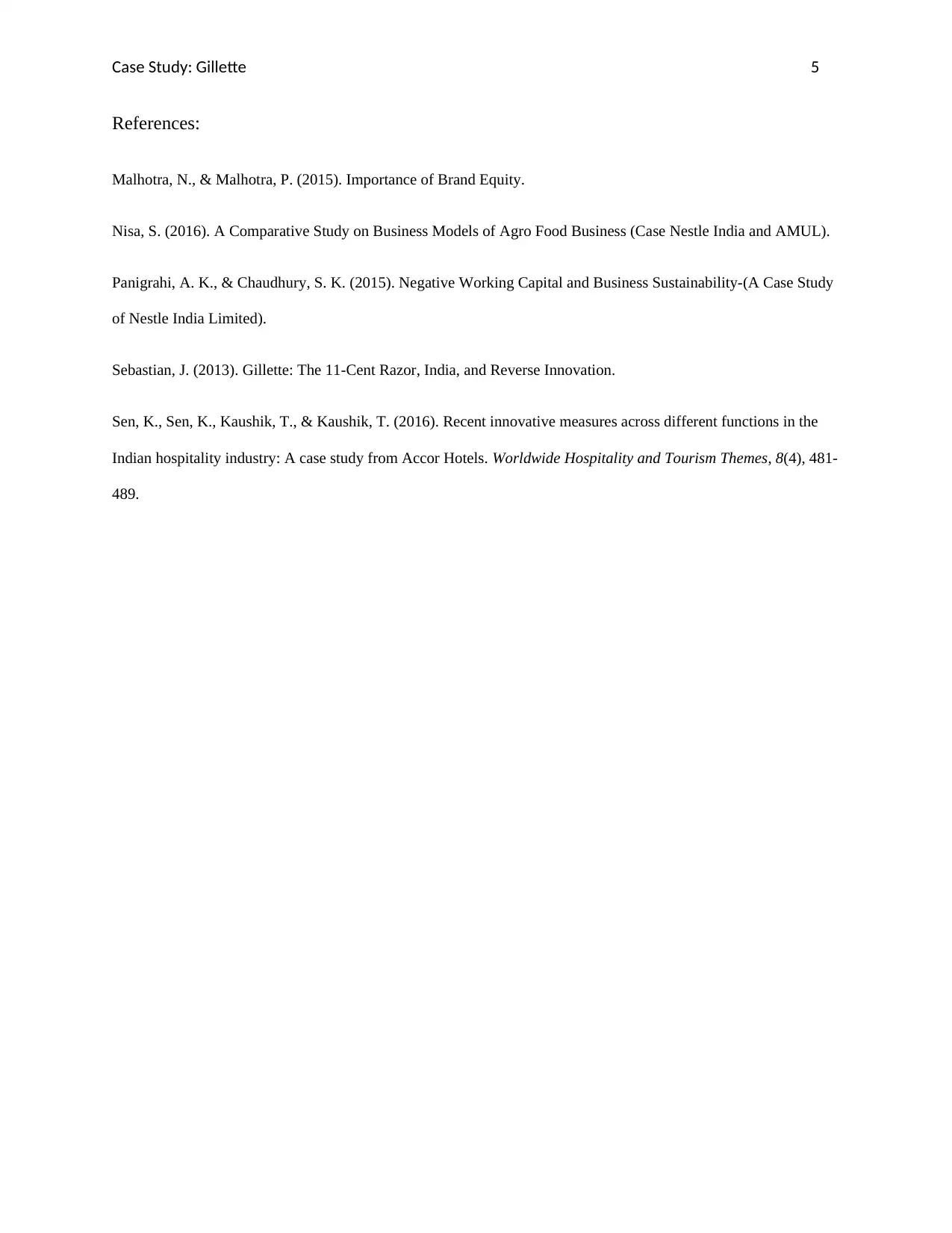
Case Study: Gillette 5
References:
Malhotra, N., & Malhotra, P. (2015). Importance of Brand Equity.
Nisa, S. (2016). A Comparative Study on Business Models of Agro Food Business (Case Nestle India and AMUL).
Panigrahi, A. K., & Chaudhury, S. K. (2015). Negative Working Capital and Business Sustainability-(A Case Study
of Nestle India Limited).
Sebastian, J. (2013). Gillette: The 11-Cent Razor, India, and Reverse Innovation.
Sen, K., Sen, K., Kaushik, T., & Kaushik, T. (2016). Recent innovative measures across different functions in the
Indian hospitality industry: A case study from Accor Hotels. Worldwide Hospitality and Tourism Themes, 8(4), 481-
489.
References:
Malhotra, N., & Malhotra, P. (2015). Importance of Brand Equity.
Nisa, S. (2016). A Comparative Study on Business Models of Agro Food Business (Case Nestle India and AMUL).
Panigrahi, A. K., & Chaudhury, S. K. (2015). Negative Working Capital and Business Sustainability-(A Case Study
of Nestle India Limited).
Sebastian, J. (2013). Gillette: The 11-Cent Razor, India, and Reverse Innovation.
Sen, K., Sen, K., Kaushik, T., & Kaushik, T. (2016). Recent innovative measures across different functions in the
Indian hospitality industry: A case study from Accor Hotels. Worldwide Hospitality and Tourism Themes, 8(4), 481-
489.
⊘ This is a preview!⊘
Do you want full access?
Subscribe today to unlock all pages.

Trusted by 1+ million students worldwide
1 out of 6
Related Documents
Your All-in-One AI-Powered Toolkit for Academic Success.
+13062052269
info@desklib.com
Available 24*7 on WhatsApp / Email
![[object Object]](/_next/static/media/star-bottom.7253800d.svg)
Unlock your academic potential
Copyright © 2020–2025 A2Z Services. All Rights Reserved. Developed and managed by ZUCOL.





